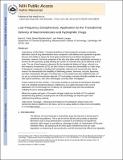| dc.contributor.author | Polat, Baris E. | |
| dc.contributor.author | Blankschtein, Daniel | |
| dc.contributor.author | Langer, Robert | |
| dc.date.accessioned | 2013-05-07T19:50:58Z | |
| dc.date.available | 2013-05-07T19:50:58Z | |
| dc.date.issued | 2010-12 | |
| dc.identifier.issn | 1742-5247 | |
| dc.identifier.issn | 1744-7593 | |
| dc.identifier.uri | http://hdl.handle.net/1721.1/78842 | |
| dc.description.abstract | Importance of the field: Transdermal delivery of macromolecules provides an attractive alternative route of drug administration when compared to oral delivery and hypodermic injection because of its ability to bypass the harsh gastrointestinal tract and deliver therapeutics non-invasively. However, the barrier properties of the skin only allow small, hydrophobic permeants to traverse the skin passively, greatly limiting the number of molecules that can be delivered via this route. The use of low-frequency ultrasound for the transdermal delivery of drugs, referred to as low-frequency sonophoresis (LFS), has been shown to increase skin permeability to a wide range of therapeutic compounds, including both hydrophilic molecules and macromolecules. Recent research has demonstrated the feasibility of delivering proteins, hormones, vaccines, liposomes and other nanoparticles through LFS-treated skin. In vivo studies have also established that LFS can act as a physical immunization adjuvant. LFS technology is already clinically available for use with topical anesthetics, with other technologies currently under investigation.
Areas covered in this review: This review provides an overview of mechanisms associated with LFS-mediated transdermal delivery, followed by an in-depth discussion of the current applications of LFS technology for the delivery of hydrophilic drugs and macromolecules, including its use in clinical applications.
What the reader will gain: The reader will gain an insight into the field of LFS-mediated transdermal drug delivery, including how the use of this technology can improve on more traditional drug delivery methods.
Take home message: Ultrasound technology has the potential to impact many more transdermal delivery platforms in the future due to its unique ability to enhance skin permeability in a controlled manner. | en_US |
| dc.description.sponsorship | National Institutes of Health (U.S.) (Grant EB-00351) | en_US |
| dc.description.sponsorship | Massachusetts Institute of Technology. Institute for Soldier Nanotechnologies (Grant DAAD-19-02-D-002) | en_US |
| dc.language.iso | en_US | |
| dc.publisher | Informa Healthcare | en_US |
| dc.relation.isversionof | http://dx.doi.org/10.1517/17425247.2010.538679 | en_US |
| dc.rights | Creative Commons Attribution-Noncommercial-Share Alike 3.0 | en_US |
| dc.rights.uri | http://creativecommons.org/licenses/by-nc-sa/3.0/ | en_US |
| dc.source | PMC | en_US |
| dc.title | Low-Frequency Sonophoresis: Application to the Transdermal Delivery of Macromolecules and Hydrophilic Drugs | en_US |
| dc.type | Article | en_US |
| dc.identifier.citation | Polat, Baris E, Daniel Blankschtein, and Robert Langer. “Low-frequency Sonophoresis: Application to the Transdermal Delivery of Macromolecules and Hydrophilic Drugs.” Expert Opinion on Drug Delivery 7.12 (2010): 1415–1432. | en_US |
| dc.contributor.department | delete | en_US |
| dc.contributor.department | Massachusetts Institute of Technology. Department of Chemical Engineering | en_US |
| dc.contributor.mitauthor | Polat, Baris E. | |
| dc.contributor.mitauthor | Blankschtein, Daniel | |
| dc.contributor.mitauthor | Langer, Robert | |
| dc.relation.journal | Expert Opinion on Drug Delivery | en_US |
| dc.eprint.version | Author's final manuscript | en_US |
| dc.type.uri | http://purl.org/eprint/type/JournalArticle | en_US |
| eprint.status | http://purl.org/eprint/status/PeerReviewed | en_US |
| dspace.orderedauthors | Polat, Baris E; Blankschtein, Daniel; Langer, Robert | en |
| dc.identifier.orcid | https://orcid.org/0000-0002-7836-415X | |
| dc.identifier.orcid | https://orcid.org/0000-0003-4255-0492 | |
| mit.license | OPEN_ACCESS_POLICY | en_US |
| mit.metadata.status | Complete | |
